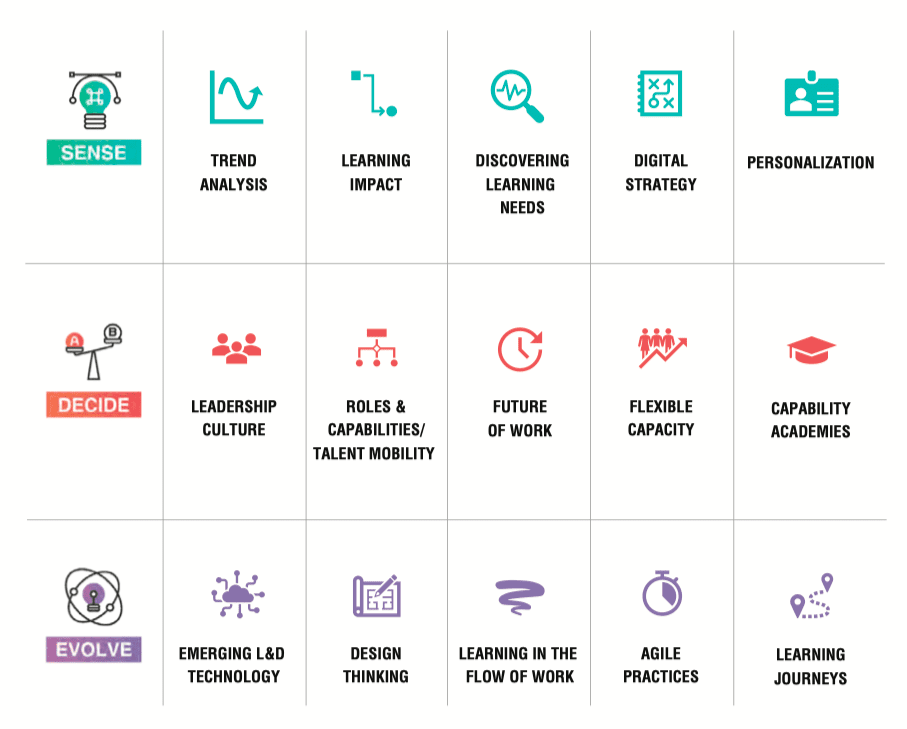Mastering Best Practices for Employee Onboarding
Unlock the secrets to successful employee onboarding with these expert tips and...


Working in the eLearning field, we have interacted with various L&D professionals during the years and we always try to be up to date with the latest challenges in this field, with the most recent innovations and current effective approaches. This is how we’ve read a lot about Adaptive Learning Organisations and we introduced the topic last week when we wrote this article.
To briefly remind you of the concept, an ALO is a company that has the skills to notice market changes, the ability to make effective decisions based on the previously observed changes and the capacity to evolve, proactively preparing themselves to respond and adapt to an ever-changing future.

Last week, we introduced the adaptive learning organisation model, with the three actions meant to drive adaptive learning, and in this article we want to have an overview of the characteristics of ALOs and how the L&Ds who adopt it can be one step ahead when market changes hit. According to Josh Bersin and his research report on adaptive learning organiations, “adaptability enables learning organisations to adjust and transform to continually evolving skills, an increasing digital landscape, and learning everywhere and anytime with greater ease”.
According to the same study written by Josh Bersin, Adaptive Learning Organisations that use this approach in the sense, decide and evolve steps are high performers, as the numbers show:
An essential characteristic of adaptive learning organisations is that the focus is put on individuals, on learning paths designed and adapted to their needs, which calls for engagement, as this article states:
It’s simple – when employees see immediate value in the training sessions, they feel more motivated to learn and apply their knowledge – improving an organization’s overall employee engagement. (source)
Adaptive Learning Organisations make the most of the evolution of technology and they are actively seeking to leverage technology to create learning opportunities that actually impact learners and to enrich training experiences among employees with the best that the digital world has to offer. According to Josh Bersin, high performers have 1.5x higher adoption of digital solutions that foster innovation, in comparison with lower performers.
An organization with a traditional form of leadership might have huge challenges in adopting an adaptive learning, which calls for a change of mindset in terms of leadership:
Adaptive leadership means teams and organizations need to constantly assess their actions, recognizing that they will have to continuously iterate and adapt their interventions as they learn more about the outcomes of decisions (source).
Thus, an organi`ation that wants to be ahead of its competitors, while staying up to date with business changes and technological evolution must adopt a completely new mindset in terms of engagement, leadership and the adoption of new technologies, a mindset that drives competitive advantage and employee performance and productivity.
This article is part of a bigger topic called: Agile.
Unlock the secrets to successful employee onboarding with these expert tips and...

Discover how just-in-time learning can revolutionize the way you approach skill...

Learn from Jen's journey and discover a storytelling approach to L&D planning that...


































































See how our product empowers real businesses.

MMM Consulting
Collaborative learning platform, easy to use, easy to integrate learners' contribution as well, not only ours, easy way to test their connection to the program because it has all sort of tracking opportunities and options.

RE/MAX
I've searched a lot for learning platforms and I find that the Knolyx platform is the best option for us. The main reason for which we've chosen Knolyx was that it is very easy to find information when we need it, you can organise and establish learning paths for newcomers.

Romanian Banking Institute
Easy-to-use learning-app with an intuitive interface and a very useful training tracker function.

Moonstar Ventures
Knolyx has been an amazing partner in developing together the most advanced learning experience platform for businesses looking to train their workforce. The platform’s modern look, simplicity and focus on a social and gamified learning experience make all the difference.

Urgent Cargus
Knolyx product has streamlined our processes, reduced costs, and provided our users with an intelligible learning experience. Through Knolyx, we managed to deliver courses more easily to all our employees and partners, and made the induction process more efficient.

Fixthephoto.com
The Knolyx learning management system offers a mix of advanced features and a contemporary UI, as the developers focused primarily on making the user experience as convenient as possible. - read more

myCareer
I like two things best: 1/ With Knolyx, you have the ability to curate the content that your learners receive, limiting overwhelm and promoting a sustainable learning curve. 2/ Knolyx is fully gamified, where you can add interactive courses, have your learners take quizzes and then reward them with progress pages!

Learning Network
Knolyx changes the perspective upon learning: from static to dynamic, by means of interaction and gamification. Learners are constantly encouraged to become an active part of the training programs, to gain knowledge and to test their learning progress. Moreover, social learning is enforced through communities of practice, which is really valuable for us.